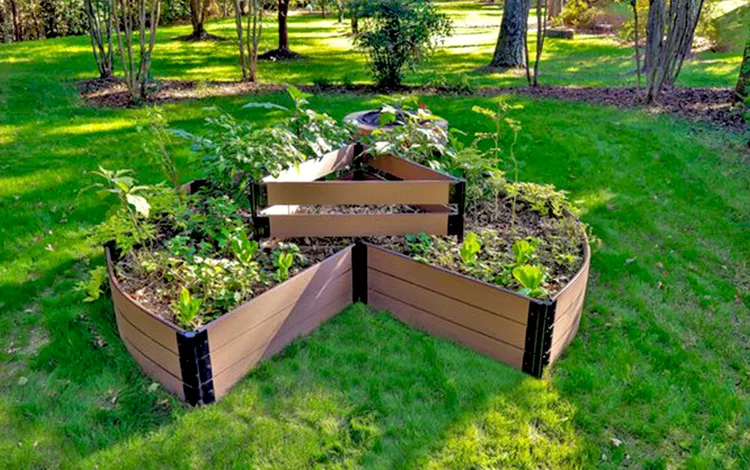Keyhole gardening may be a newer trend in the United States, but it actually started in Africa in the 1990s, where it provided a way to grow fresh produce in drought-stricken areas with poor soil. While there are plenty of variations, most keyhole gardens are rounded raised beds with a notch cut into the middle (similar to a keyhole, hence the name) to allow for easy access to the entire plot. In the middle of the plot sits a basket for composting and watering. The planting bed can be filled with garden soil; compostable materials such as cardboard, newspaper, grass clippings, coffee grounds and other kitchen scraps, and manure; or a combination of the two.
Benefits of Keyhole Gardening
A keyhole garden's raised profile makes it ideal for places with subpar soil (bonus: There's no digging or tilling required). The elevation also makes it easier for those with mobility challenges to plant, tend, and harvest. Plus, keyhole gardens are ecological and budget friendly. They can be created at a very low cost, using natural materials and things you may already have on hand. The compost basket provides a convenient, mess-free way to give plants much-needed nutrition without a separate compost bin. If you use layers of organic material in the bed itself, it will help retain moisture, leading to less watering.
How to Create a Keyhole Garden
Similar to building a raised bed, there are many ways to set up your own keyhole garden depending on budget, preferences, and space. Luckily, the process is simple and straightforward.
Site Your Location
Look for an area that's relatively flat. Avoid low-lying areas where water collects. Ensure the area receives at least six hours of direct sunlight per day.
Determine Shape and Size
While most keyhole gardens are circular, you can create virtually any shape to suit your space. Just be sure it's six feet or less in diameter so you can easily reach all of your plants. Create a notch in the middle wide enough for you to walk into (two feet wide will work for most) to reach the compost basket. Mark out your spot by laying down a base layer of stone, brick, or wood. You could also opt for a premade kit, in which case you would skip the next two steps.
Create Your Compost Basket
Use a perforated or mesh material, such as chicken wire, to create a compost basket. Simply roll up the wire to approximately 12 inches in diameter and several inches taller than the walls of your structure. Tie it together with twine or zip ties and place in the middle of the garden.
Build the Walls
Your keyhole garden structure can be made from a wide variety of materials, including bricks, cinder blocks, stones, or wood. Aim for about three feet high. If the walls are porous, add a layer of cardboard around the perimeter of the inside to help keep everything contained.
Add Soil and/or Other Materials
If you're adding garden soil, simply fill the bed to the top. Or, add compost materials per the lasagna method, then top with a layer of soil and/or manure.
Plant Your New Keyhole Garden
Now you're ready to grow your favorite produce (and perhaps even a few flowers). Leafy greens and smaller root vegetables such as carrots, onions, beets, radishes, and turnips tend to grow best in keyhole gardens, while larger crops like beans and squash may struggle. Look for compact varieties to maximize your space and allow you to grow a wider variety of produce.
Keep Composting and Watering
As the growing season progresses, continue to add materials to the compost basket. (Hint: It's a convenient place to throw the weeds you pull up from your keyhole garden as long as the plants haven't gone to seed yet.) Whenever the soil seems dry, add water to the basket to help disperse both compost nutrients and moisture to the entire bed.
Overall, keyhole gardens are relatively low maintenance. However, if the quality of your produce starts to deteriorate over the years or the soil level starts to fall, you may need to add some fresh soil and compost to the bed.




















